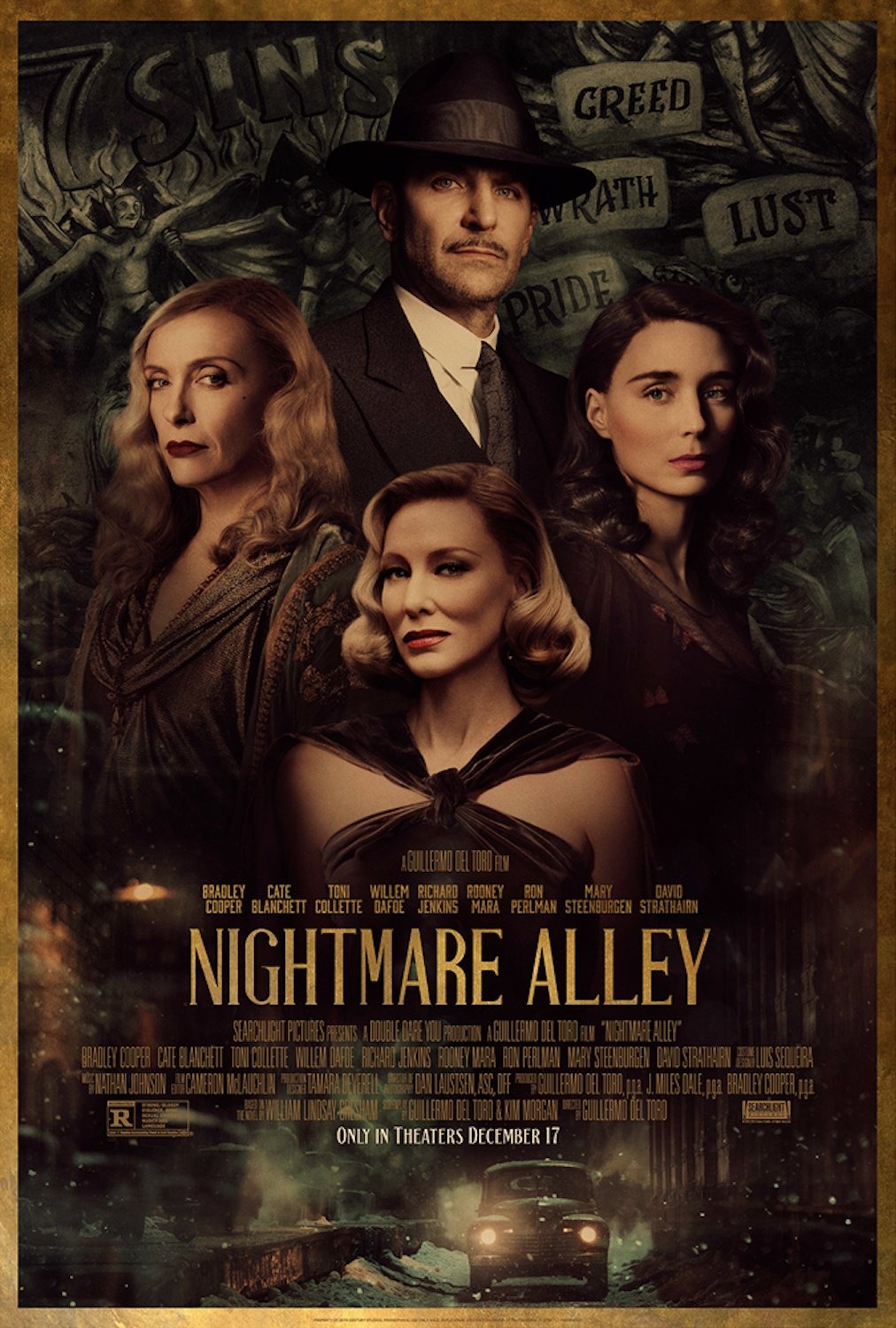
02 Dec Nightmare Alley Review
NIGHTMARE ALLEY
dir. Guillermo del Toro, starring Bradley Cooper, Cate Blanchett, Rooney Mara, and Richard Jenkins
Nightmare Alley, a neo-noir thriller set in the late 1930s, is centered on Stanton Carlisle, an overly ambitious circus carny with a penchant for manipulating people through words. His games of deception leads him to cross paths with the dangerous Dr. Lilith Ritter, a psychiatrist who’s equally manipulative and cunning in her own right. As Stan is drawn more into Lilith’s world and Lilith into Stan’s the boundaries between partners and adversaries are muddied.
Guillermo del Toro’s eleventh film, Nightmare Alley proves yet again that his best work is done in period pieces. Adapting William Lindsay Gresham’s 1946 novel, the film also afforded him the opportunity to tell a story with noir trappings, a dream of his. Fortunately, del Toro delivers in spades with the noir; there’s enough cigarette smoking protagonists, femme fatales, and ulterior motives to make even Dashiell Hammett proud. Unfortunately, getting to these highlights takes far too long as the first act of the film lasts approximately an eternity setting up the carnival life, hinting at Stan Carlisle’s mysterious past, and establishing the relationship between Carlisle and Molly Cahill. del Toro’s love of the darkly macabre and a peek behind the lens of the traveling circus (a setting rife with possibility for seediness) should’ve been a perfect combination for the veteran director to craft a story featuring his signature style and tone. What this leads to, however, is del Toro taking far too long to immerse the audience in this environment, leading to a self indulgent first act that almost stalls the film before it gains traction. Once Stan locks horns with Blanchett’s Dr. Lilith Ritter, the film’s entire tone shifts, and del Toro manages to build intrigue and suspense into the cat-and-mouse game between the two.
Starring Bradley Cooper, Nightmare Alley’s theme of ambition vs greed is handled deftly by the Academy nominated actor. The backbone of the film, Cooper’s Stan Carlisle is in almost every scene as the audience watches the ascension and downfall of a character who’s past is hinted at, but never really explained. Cooper brings his usual charm and radiant blue eyes to every scene as he works to hustle everyone in his immediate vicinity. A product of survival, Stan’s grasp just barely exceeds his reach and Cooper plays the fall better than he does the rise. Joining Stan in the journey to shuck as many people out of money as they can is Rooney Mara’s Molly Cahill, a circus performer that joins Stan in his mindreading capers. Content to handle the workload they possess when the audiences catch up with them, Mara’s Molly is more or less the audience’s conduit into the film, recognizing the crumbling of the circumstances and the need to escape. Mara is magnificent in the role, transforming from innocent performer to cagey hustler with a knack for knowing when enough is enough.
Rounding out the main group of actors are Cate Blanchett as psychologist Dr. Lilith Ritter and Richard Jenkins as Ezra Grindle, the mark. Blacnhett’s entrance into the film immediately provides it with a much needed breath of fresh air; as the viewer recognizes the imminent threat Ritter is to Stan and Molly, Nightmare Alley’s shift in tone becomes exciting and palpable. Blanchett, someone rarely prone to turning in a bad performance, is the shining performer of Nightmare Alley. Wrapped in an air of mystery, contempt, and manipulation, Ritter is the very essence of film noir. While her overall motivations could’ve been made clearer, enough is communicated that viewers can enjoy the multitude of levels of Blanchett’s performance to never quite be sure until the end whether or not she can be trusted. Richard Jenkins as Ezra Grindle, easily manipulated by his haunted past, is given little to do in the movie except play the vessel through which Stan, Molly, and Lilith carry out their schemes.
One of the rare outings where del Toro chooses to shy away from his signature supernatural or fantastical elements, Nightmare Alley mostly succeeds in the tone and environment he sets. The circus Stan finds himself a part of seems innocent enough: the members chat and eat and drink with each other like any community of like-minded individuals. Underneath all that, as Stan finds out quickly enough, lies the manipulation, the lies, and the bodies. The phrase cut to the chase applies here; were this first bit with the circus a good 20 to 30 minutes lesser, the audience would be presented with the real intrigue of the movie, the relationship between Stan and Dr. Ritter. As is usually the case with period piece films, the costuming, hair and makeup, and production design are all standouts of the film, presenting an engaging look at late 1930s America.
Overall, the positive aspects of Nightmare Alley just barely manage to tips the scales in its favor. An overstuffed film with a bloated first act, its 139 minute runtime could’ve been served with a heavy, judicious hand in the editing room. Bradley Cooper’s chemistry with Cate Blanchett make for the film’s steamiest scenes and what should’ve been the entire focus of the film from the outset. A movie that meanders and takes far too long to find its footing is saved by its final scene, telegraphed from miles away, yet incredibly satisfying nonetheless. A must for fans of del Toro, Nightmare Alley can be cautiously approached by all others. Nightmare Alley hits theaters December 17th.
Review by Darryl Mansel


No Comments